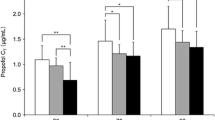Abstract
Purpose
The purpose of this study was to compare the dose-related effects of fentanyl on systemic hemodynamics, hormone release and cardiac output in response to endotracheal intubation in patients with and without hypertension.
Methods
Forty-five patients without hypertension and 45 patients with hypertension (total 90 patients) undergoing elective general surgical, urological or gynecological procedures under general anesthesia were studied. The patients were randomly divided into three groups to receive either saline (control), 2.0 μg/kg fentanyl or 4.0 μg/kg fentanyl before tracheal intubation. Anesthesia was induced via intravenous target controlled infusion of propofol (plasma concentration, 4.0 μg/mL) followed by administration of the three drugs. Heart rate, blood pressure, and cardiac output were continuously monitored using Flo Trac/Vigileo system™ and Bispectral index from before anesthetic induction until 10 min after tracheal intubation.
Results
In patients without hypertension, there was a significant difference in mean arterial pressure (MAP) among the three groups 2 min after intubation. Cardiac index (CI) in all three groups decreased before intubation compared with that in the awake period, returning to awake values after intubation in all three groups. There was a significant difference in CI between the 4 μg/kg fentanyl group and the other two groups immediately and 1 min after intubation.
In patients with hypertension, a differential time course of MAP changes was observed among the three groups after intubation. CI in the three groups decreased after the induction of anesthesia and increased after intubation in control and 2 μg/kg fentanyl groups compared with that in the awake period.
Conclusions
The present study shows that it is preferable to administer 2 μg/kg fentanyl in patients without hypertension and 4 μg/kg fentanyl in patients with hypertension in order to minimize the changes in heart rate, systolic blood pressure and cardiac output associated with tracheal intubation.

Similar content being viewed by others
References
Russell WJ, Morris RG, Frewin DB, Drew SE. Changes in plasma catecholamine concentrations during endotracheal intubation. Br J Anaesth. 1981;53:837–9.
Alanoğlu Z, Ateş Y, Yilmaz AA, Tüzüner F. Is there an ideal approach for rapid-sequence induction in hypertensive patients? J Clin Anesth. 2006;18:34–40.
Low JM, Harvey JT, Prys-Roberts C, Dagnino J. Studies of anaesthesia in relation to hypertension. VII: adrenergic responses to laryngoscopy. Br J Anaesth. 1986;58:471–7.
Prys-Roberts C, Meloche R, Foëx P. Studies of anaesthesia in relation to hypertension. I. Cardiovascular responses of treated and untreated patients. Br J Anaesth. 1971;43:122–37.
Prys-Roberts C, Greene LT, Meloche R, Foëx P. Studies of anaesthesia in relation to hypertension. II. Haemodynamic consequences of induction and endotracheal intubation. Br J Anaesth. 1971;43:531–47.
Wax DB, Porter SB, Lin HM, Hossain S, Reich DL. Association of preanesthesia hypertension with adverse outcomes. J Cardiothorac Vasc Anesth. 2010;24:927–30.
Miller DR, Martineau RJ, O’Brien H, Hull KA, Oliveras L, Hindmarsh T, Greenway D. Effects of alfentanil on the hemodynamic and catecholamine response to tracheal intubation. Anesth Analg. 1993;76:1040–6.
Miyazaki M, Kadoi Y, Takashi S, Sawano Y, Shimada H. Comparative effects of propofol, landiolol, and nicardipine on hemodynamic and bispectral index responses to endotracheal intubation: a prospective, randomized, double-blinded study. J Clin Anesth. 2008;20:257–62.
Maguire AM, Kumar N, Parker JL, Rowbotham DJ, Thompson JP. Comparison of effects of remifentanil and alfentanil on cardiovascular response to tracheal intubation in hypertensive patients. Br J Anaesth. 2001;86:90–3.
Sharma S, Mitra S, Grover VK, Kalra R. Esmolol blunts the haemodynamic responses to tracheal intubation in treated hypertensive patients. Can J Anaesth. 1996;43:778–82.
Figueredo E, Garcia-Fuentes EM. Assessment of the efficacy of esmolol on the haemodynamic changes induced by laryngoscopy and tracheal intubation: a meta-analysis. Acta Anaesthesiol Scand. 2001;45:1011–22.
Van Aken H, Meinshausen E, Prien T, Brüssel T, Heinećke A, Lawin P. The influence of fentanyl and tracheal intubation on the hemodynamic effects of anesthesia induction with propofol/N2O in humans. Anesthesiology. 1988;68:157–63.
Martin DE, Rosenberg H, Aukburg SJ, Bartkowski RR, Edwards MW Jr, Greenhow DE, Klineberg PL. Low-dose fentanyl blunts circulatory responses to tracheal intubation. Anesth Analg. 1982;61:680–4.
Helfman SM, Gold MI, DeLisser EA, Herrington CA. Which drug prevents tachycardia and hypertension associated with tracheal intubation: lidocaine, fentanyl, or esmolol? Anesth Analg. 1991;72:482–6.
Feng CK, Chan KH, Liu KN, Or CH, Lee TY. A comparison of lidocaine, fentanyl, and esmolol for attenuation of cardiovascular response to laryngoscopy and tracheal intubation. Acta Anaesthesiol Sin. 1996;34:61–7.
Adachi YU, Satomoto M, Higuchi H, Watanabe K. Fentanyl attenuates the hemodynamic response to endotracheal intubation more than the response to laryngoscopy. Anesth Analg. 2002;95:233–7.
Inomata S, Maeda T, Shimizu T, Satsumae T, Tanaka M. Effects of fentanyl infusion on tracheal intubation and emergence agitation in preschool children anaesthetized with sevoflurane. Br J Anaesth. 2010;105:361–7.
Higuchi T, Maeta M, Ishio Y, Shimizu T, Tsubaki N, Asao Y. Asystole after anesthetic induction with remifentanil. Masui. 2007;56:1339–42.
Reid JE, Mirakhur RK. Bradycardia after administration of remifentanil. Br J Anaesth. 2000;84:422–3.
Naito A, Endo T, Inoue J, Okuno S, Uchida O, Kawahara R. Comparative study of anesthesia with remifentanil VS fentanyl in terms of postoperative pain and shivering. Masui. 2009;58:77–80.
Sato K. Anticipated changes in the management of anesthesia with use of remifentanil–its clinical application in comparison with fentanyl and morphine. Masui. 2007;56:1274–80.
Fukuda I. Clinical usefulness of the Flo Trac system—efficacy of arterial pressure-based cardiac output and stroke volume variations. J Jpn Clin Anesth. 2011;31:81–90.
Guarracino F, Lapolla F, Cariello C, Danella A, Doroni L, Baldassarri R, Boldrini A, Volpe ML. Target controlled infusion: TCI. Minerva Anestesiol. 2005;71:335–7.
Author information
Authors and Affiliations
Corresponding author
About this article
Cite this article
Sawano, Y., Miyazaki, M., Shimada, H. et al. Optimal fentanyl dosage for attenuating systemic hemodynamic changes, hormone release and cardiac output changes during the induction of anesthesia in patients with and without hypertension: a prospective, randomized, double-blinded study. J Anesth 27, 505–511 (2013). https://doi.org/10.1007/s00540-012-1552-x
Received:
Accepted:
Published:
Issue Date:
DOI: https://doi.org/10.1007/s00540-012-1552-x




